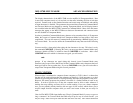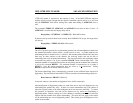
MFJ-1278B MULTI-MODE ADVANCED OPERATION
1278B will assume is required for the repeater to drop. If the MFJ-1278B has detected
channel activity recently enough that the repeater transmitter should still be on, it will wait
only the TXDELAY time before sending data, rather than adding an AXDELAY time as
well.
The commands TXDELAY, AXDELAY, and AXHANG all set times in units of 10 ms. If
AXDELAY is in effect the total keyup delay will be
Keyup delay = (TXDELAY + AXDELAY) * 10 in milliseconds.
If channel activity has been heard more recently than AXHANG*10 ms ago, the keyup delay
will only be
Keyup delay = TXDELAY*10 in milliseconds.
Packet Timing
The AX.25 protocol provides for re-transmitting packets if no acknowledgment is heard from
the intended destination station within a certain period of time. A packet might not be
acknowledged due to channel noise or "collision" with another packet transmission, and since
there may be other stations on the channel, the receiving station may not be able to
acknowledge the received packet immediately. The time lapse before the originating station
re-transmits the packet is set by the command FRACK (frame acknowledge time). The
maximum number of re-transmissions before the originating station terminates the connection
is set by the command RETRY. The maximum number of transmissions of a packet is
RETRY+1, since the initial transmission does not count as a re-transmission. Setting
RETRY to 0 specifies an infinite number of retries.
The frame-acknowledge time is automatically corrected for the additional time required for
digipeating. The time interval before MFJ-1278B re-transmits an unacknowledged packet is:
Retry interval = FRACK * (2*n + 1)
in seconds, where n is the number of digipeaters in use for this connection.
Acknowledgments of digipeated packets are made from end to end, and digipeaters do not
acknowledge the packets they relay. If there are several intermediate relays, the chance of
either the original packet or the acknowledgment to be lost increases drastically. To reduce
this problem, an automatic wait time can be imposed on any station not transmitting a
digipeated packet. Stations waiting for a clear channel to transmit packets wait for this time
interval after the channel clears before transmitting. This wait does not apply if the station
will be transmitting one or more digipeated packets. This usually gives the digipeater a clear
chance at the channel.


















